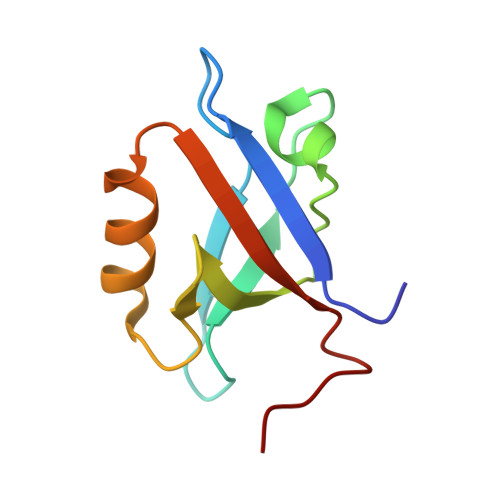New Conformational State of NHERF1-CXCR2 Signaling Complex Captured by Crystal Lattice Trapping.
Jiang, Y., Lu, G., Trescott, L.R., Hou, Y., Guan, X., Wang, S., Stamenkovich, A., Brunzelle, J., Sirinupong, N., Li, C., Yang, Z.(2013) PLoS One 8: e81904-e81904
- PubMed: 24339979
- DOI: https://doi.org/10.1371/journal.pone.0081904
- Primary Citation of Related Structures:
4LMM, 4MPA, 4N6X - PubMed Abstract:
NHERF1 is a PDZ adaptor protein that scaffolds the assembly of diverse signaling complexes and has been implicated in many cancers. However, little is known about the mechanism responsible for its scaffolding promiscuity or its ability to bind to multiple targets. Computational studies have indicated that PDZ promiscuity may be attributed to its conformational dynamics, but experimental evidence for this relationship remains very limited. Here we examine the conformational flexibility of the NHERF1 PDZ1 domain using crystal lattice trapping via solving PDZ1 structure of a new crystal form. The structure, together with prior PDZ1 structures of a different space group, reveals that 4 of 11 ligand-interacting residues undergo significant crystal packing-induced structural changes. Most of these residues correspond to the residues involved in allosteric transition when a peptide ligand binds. In addition, a subtle difference in ligand conformations causes the same peptide to bind in slightly different modes in different crystal forms. These findings indicate that substantial structural flexibility is present in the PDZ1 peptide-binding pocket, and the structural substate trapped in the present crystal form can be utilized to represent the conformational space accessible to the protein. Such knowledge will be critical for drug design against the NHERF1 PDZ1 domain, highlighting the continued need for experimentally determined PDZ1-ligand complexes.
Organizational Affiliation:
Department of Biochemistry and Molecular Biology, Wayne State University School of Medicine, Detroit, Michigan, United States of America.



















